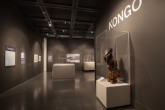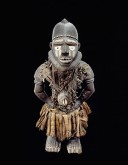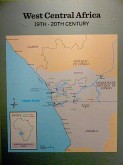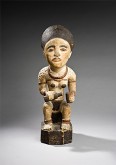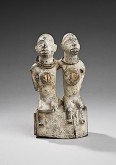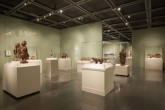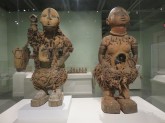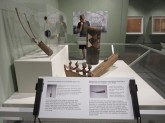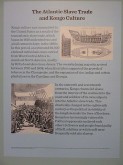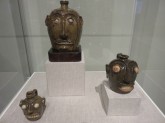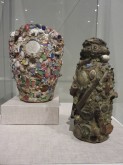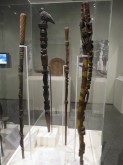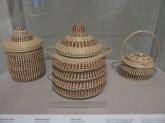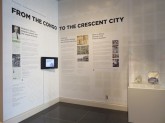The browser will either open the file, download it, or display a dialog.
Kongo Across the Waters
Harn Museum of Art
Gainesville, Florida
October 22, 2013–March 23, 2014
Jimmy Carter Presidential Library and Museum
Atlanta, Georgia
May 15, 2014–September 21, 2014
Princeton University Art Museum
Princeton, New Jersey
October 25, 2014–January 25, 2015
New Orleans Museum of Art
New Orleans, Louisiana
February 27, 2015–May 25, 2015
This past spring, the New Orleans Museum of Art was the final and largest venue of a pioneering four-city tour of Kongo Across the Waters. Co-organized by the Harn Museum of Art at the University of Florida and the Royal Museum for Central Africa in Tervuren, Belgium, (RMCA Tervuren), this was the first exhibition in the United States to examine the legacy of Kongo culture in depth. The show featured more than 160 works of historic and contemporary art and artifacts, including loans from RMCA Tervuren, which have never been on display stateside and several archeological discoveries that had never before been exhibited. Scholars developed the exhibition and accompanying catalogue for 2013 to highlight the 500th anniversary of the first presence of Africans in Florida and as a complement to Viva Florida 500, a program to commemorate 500 years of European presence in that state. The Spanish conquistador Juan Ponce de Leon arrived on La Florida in April 1513 with two free African men on his crew. Hence, the first Europeans and first Africans in North America arrived simultaneously, which is both historically and symbolically significant. Although the exhibition included items from the sixteenth century to the present, more than two-thirds of the pieces date from the long nineteenth century. Accordingly, this review primarily concerns the installation of those works, spotlighting the most visually and culturally compelling material.
An almost fifty-two inch tall wooden Kongo anthropomorphic power figure or nkisi nkondi (nineteenth century) dominated a glass display case in the first gallery of Kongo Across the Waters (fig. 1). Hands on hips and feet planted apart firmly, the dark male figure seems to emphatically address the viewer with his forward-leaning stance, intense stare of pinpoint pupils in large white, half-circle glass eyes, and open mouth of filed teeth (fig. 2). Clearly a symbol of judicial authority, his chest bristles with embedded nails. A cowrie shell embellishes the protuberance in his abdomen stuffed with medicinal substances.
A nkisi (pl. minkisi), a kind of charm, is an object for which no equivalent word exists in European languages. It is a container for an ancestral spirit and vegetal, mineral, and/or animal “medicines.” A ritual expert, a nganga, selected the items for their metonymic or visual and linguistic metaphorical attributes. Most people understood what was included, but some elements were more esoteric, underscoring the expert’s sophisticated knowledge. The container could take many forms and be associated with one or several diseases, which it could either cure or inflict. This imposing work of art demands engagement and was an apt introduction to the vibrant culture of Kongo peoples from West Central Africa and the transmission of that culture in the United States.
During more than 500 years, Kongo peoples developed a vast kingdom south of the Congo River. (See the simplified but informative maps in fig. 3; regions, places, people, and landmarks are identified by labels in various colors and typographical formats.) After they arrived on the Kongo coast in 1483, Portuguese traders’ ships took fine textiles and ivory carvings back to Europe. King Nzinga a Nkuwu’s conversion to Christianity in 1491 launched the active participation of Kongo elites in an emerging Atlantic creole culture. As the Portuguese demand for slaves increased, Kongo supplied people from the more remote interior of Central Africa. Later, thousands of Kongolese were taken to plantations in the Americas. They constituted the largest single group of enslaved Africans and made an indelible mark on the development of African American cultures. Kongo heritage is present in diverse folk arts, music, dance, and the archeological record. Kongo Across the Waters highlighted Kongo history and culture in both West Central Africa and the southern United States, and expressed how Kongo art continues to inspire artists currently.
The initial part of the exhibition featured works from the sixteenth through eighteenth centuries, including an Italian map of the Kongo kingdom (1598), an engraving in a book of Dutch ambassadors visiting the court of Kongo in 1642, honorific iron swords, raffia textiles, ivory horns, Kongolese crucifixes (accompanied by a wall text about Kongo conversion to Christianity), brass staff finials, and religious medals. A helpful label, “Kongo or Congo?” explained that Kongo denoted West Central African where speakers of the Bantu language Kikongo live. The Kongo kingdom of the sixteenth and seventeenth centuries occupied territory mostly south of the Congo River about the size of Louisiana or Alabama. King Leopold II of Belgium governed the colony known as the Etat Indépendant du Congo or Congo Free State from 1885 to 1908. It was named a Belgian Colony after its transfer to the Belgian state. In 1960 independence came for the Republic of Congo, called Zaire, 1971–97. Officially, the country’s name is now the Democratic Republic of Congo, often called Congo-Kinshasha to distinguish it from the Republic of Congo or Congo-Brazzaville, its northern neighbor.
In the subsequent section, a wall text summarized “Kongo in the Nineteenth Century.” Kongo flourished when “legitimate” commerce developed after the slave trade ended, selling raw materials, such as palm oil and rubber to Europe. Wealthy people acquired imported luxury items and redistributed them during elaborate rituals of investiture for new chiefs. An example of a luxury item depicted in sculpture is a square jenever bottle held by a Yombe wooden grave figure (fig. 4). Here, a seated, topless woman, adorned with jewelry around her neck, upper arms, wrists, and ankles, pours Holland gin or Dutch gin into a cup. Also known as genever, the juniper-flavored liquor is the national and traditional drink of the Netherlands and Belgium, from which gin evolved. In 1907, a Belgian engineer described colorful wooden statues, some up to a meter tall, on the chiefs’ tombs in Mayombe. Protected from rain by a shelter of banana wood and leaves, the tombs were also decorated with numerous glass bottles and European printed textiles. Another work on view related to commercial exchanges is a small Lemba couple, less than nine inches tall and painted with white pigment (fig. 5). Lemba developed a rich material culture with a distinct iconography. The couple sits on a carved chest used to store raffia currency. Both the man and woman wear iron neck rings, and have bilongo, or medicines, and a cowrie shell placed above the belly, visual clues to the empowerment of their marriage.
Other works in this section are effective symbols of power (fig. 6). For example, the two stunning minkisi placed in the center of the room represent another married couple (fig. 7). While the faces and headwear of these tan figures are not nearly as defined as that of the nkisi in the initial gallery (eyes are smaller and cloudy, and the slightly parted lips reveal no teeth), they have layers of clay encrustation on their chests and knotted rope bundles of other substances around their loins and legs that the first nkisi lacks. The husband, whose right arm is upraised, originally held a knife. The female, if needed, could soften the more vigorous powers of the male. Such minkisi hunted down thieves and witches and also could be used for sealing trade agreements.
An object that signified both the temporal military power and the spiritual power that a chief needed to rule is summarized visually in a remarkable ivory scepter made from the tip of an elephant’s tusk (fig. 8). Here, a chief sits, legs crossed, holding a small tusk in his left hand. It may be a medicine container or a self-reference to the scepter. In his other hand he holds a munkwisa root and bites it. This root was used for many purposes, such as warding off witches and killing someone if the chief pointed it at an individual. The root could symbolize the power of life and death that a chief wielded over his domain as well as his fertility and that of his people. The ruler’s life-and-death powers are more evident in the secondary figure below the chief facing the opposite direction. Gagged and bound to a pole, the victim awaits execution.
The setting for these minkisi, the scepter and other works was spacious and effective in well-lit galleries with high ceilings, on white pedestals or on beige, linen-covered mounts in glass cases, and with sage green walls. While elegant and subdued, the installation was not exciting. One wishes there had been more saturated wall colors and/or colorful labels, as in displays at the National Museum of African Art in Washington, DC.
A more engaging section of the exhibition concerned Kongo musical instruments, such as a ngoma drum and a mpungi horn (fig. 9). Viewers could listen to 1-1/2-minute sound clips of traditional music still known and performed in the 1970s, some with elaborate vocal parts, in call and response fashion. Compositions included one song that was originally performed at the execution of a wrongdoer, another was about a buffalo hunt, and one invoked nkita spirits. Europeans collected Kongo wind, percussion, and plucked instruments long ago, as demonstrated by their appearance in early seventeenth-century German encyclopedias of musical instruments.
One of the efficacious wall texts, “The Atlantic Slave Trade and Kongo Culture,” featured familiar reproductions of prints, such as the cross-section of a slave ship and seated slaves crowded on deck (fig. 10). The transatlantic slave trade existed 1619–1860s. Mostly British and American slavers forcibly brought an estimated 92,000 West Central Africans to mainland North America, the majority arriving between 1720 and 1808. Slave labor cultivated tobacco in the Chesapeake and rice, cotton, and indigo in the Carolinas and Georgia.
Kongo ideas and aesthetics are evident in African American ceramics, canes, and baskets, as well as metal and woodwork. Similarities can be seen in form, decoration, and manufacturing technique. Such “cognates,” the curators asserted, may not be direct survivals, but share a “cultural DNA” that creators on both sides of the Atlantic put into unique objects.
Many people of African descent, including some from the Kongo region, lived in Middle Georgia and in the Edgefield district of South Carolina. In local potteries Kongolese may have produced jars with facial relief features for their own use. Face vessels may have been used on graves or for apotropaic purposes (fig. 11). By the end of the nineteenth century, African Americans were coating clay jars in plaster and embedding them with souvenirs of deceased relatives (fig. 12). The first documentation of African American use of embellished memory jars as grave adornments dates from 1880 in Georgia. This technique echoes the tradition of Bakongo chiefs, who had elaborate graves decorated with personal objects that reflected their last connections with life. This legacy, as well as the use of shiny objects to invoke spiritual power, is reflected in some African American gravesites, which can include seashells, clocks, lamps, glass bottles, figurines, crockery, and materials related to the deceased’s faith or occupation. Seashells may allude to the Middle Passage or the passage to the realm of the ancestors below water and symbolize immortality.
African American wooden canes emulate Kongo chiefly staffs as prestigious and protective accessories. They share similar iconography, featuring reptiles—liminal creatures that the Kongo identify as inhabiting both earthly and spiritual realms—and/or commanding figures on the finials depicting leaders. Just as African carvers sometimes studded staffs with metal bosses, wrapped wire, or fibers, African American cane makers embedded nail tacks, rhinestones, organic materials, and other objects in the walking sticks to enhance and engage spiritual powers. While the cane by Henry Gudgell (ca. 1867) has been published extensively, it was refreshing to see it beside carvings by Pete Dilbert (1988), Lenard Megarr (1932), and an unknown maker from the late nineteenth century (fig. 13). The installation of the four pieces upright in a freestanding case meant that viewers could see all sides of them. Dilbert’s metal support had an appropriately dark hue, but the other three white mounts were distracting.
As early as the eighteenth century, the Gullah people of the of the Sea Islands of Georgia and South Carolina made baskets by sewing grass bundles together in a continuous coil, a technique passed down by West and Central Africans who worked on rice plantations. Baskets were used for fanning rice, carrying food and utensils, and for storage. The exhibition included simple pieces such as a lidded workbasket (ca. 1875) and two fanner baskets (ca. 1900 and ca. 1920). More complicated, non-agrarian baskets have been sold commercially since the early twentieth century. The Gullah basket makers’ artistry has featured new techniques, materials, and designs, garnering national and international recognition (fig. 14).
The final section of the exhibition featured Kongo inspiration in contemporary world art (ca. 1993–2011) with work by such artists as African Americans Renée Stout and Radcliffe Bailey, Cuban-American José Bedia, Haitian Edouard Duval-Carrié, and Congolese Steve Bandoma.
A unique complement to the traveling exhibition at the New Orleans Museum of Art (NOMA) was the corner display of From the Congo to the Crescent City, featuring local connections to the Kongo via reproductions of historical photographs and documents, a video installation, and a small case of archeological objects uncovered in the French Quarter (fig. 15). This was divided into three sections, with one on the left wall, “Mobutu’s Zaire, A Belgian Curator and the Loyola Archives.” Authoritarian ruler Mobutu Sese Seko sought to purge the former Belgian Congo of its colonial inheritances when central Africa’s largest state became Zaire in the early 1970s. He engaged the Belgian missionary and scholar Frère Joseph-Aurélien Cornet to conduct research on the art and peoples of the Congo Basin, establish new national collections, and mount exhibitions abroad over three decades. Cornet developed relationships with New Orleans art collectors, dealers, scholars, and the art museum that lasted even after the fall of Mobutu in 1997. Cornet left his archives to Loyola University in New Orleans. This section included a photo of Cornet, correspondence documenting research authorization, ethnographic photography by Cornet, and a fieldwork notebook extract. Also on the wall was a Samsung flatscreen with the static electronic image of Cornet standing near three Africans; a running video was in the process of being installed.
On the facing wall were two sections. The first was “Exploring Henry Morton Stanley, New Orleans and Africa.” John Rowlands, a Welsh-born cabin boy, jumped ship in 1859 when he arrived in the Crescent City and began his transformation into the famed African explorer. In 1871 a New York newspaper commissioned Stanley to find the “lost” missionary, Dr. David Livingstone. Afterward, Stanley joined Livingstone’s call to end the East African “Arab” slave trade. Reproductions here were of the young Rowlands, Stanley posing in expedition garb, Stanley with porters, the Goodrich-Stanley house, once owned by Stanley’s supposed “adoptive” father, and 105 Tchoupitoulas Street, once occupied by the wholesale grocery that employed Rowlands/Stanley.
The last part of this display was “Born in Africa, Buried in the French Quarter?” This concerned the recent excavation of New Orleans’ oldest formal graveyard, the St. Peter Street cemetery, which held some of the city’s first African residents among the approximately 8,000 people interred. The cemetery was in use ca. 1718–late 1700s. Four photographs documented the removal of coffins. On April 18, 2015, there was a ceremony to mark the re-interment of St. Peter Street remains in New Orleans’ Saint Louis Cemetery No. 1. In the case were examples of small artifacts, such as pottery shards and cowrie shells, recovered from Madame John’s Legacy, a property of the Louisiana State Museum, in New Orleans’ French Quarter. There were also pieces of ‘colono-type’ wares from the East Coast, reflecting the city’s Colonial population, as well as industrially-manufactured pottery from England. The transfer-printed platter, serving bowl, and smaller bowl came from a privy in the 1860s on St. Peter Street.
These three vignettes about local ties to international history effectively deepened the already chronologically and geographically broad context of Kongo Across the Waters, a remarkably ambitious, landmark exhibition full of high-quality works. The display of these pieces, many never before seen in the United States, was gracious and attractive although less dynamic than it might have been. The accessible labels allowed viewers to grasp the significance of five centuries of Kongo culture and history and their enduring legacies in the Americas.
There has been a recent surge in scholarship about Kongo culture, both in terms of publications and highly visible, large-scale exhibitions. In December 2014, Cécile Fromont published The Art of Conversion: Christian Visual Culture in the Kingdom of Kongo (Chapel Hill, NC: University of North Carolina Press) for the Omohundro Institute of Early American History and Culture at Williamsburg, Virginia. It concerns Catholic Kongo between the sixteenth and nineteenth centuries. In 2013, Bárbaro Martínez-Ruiz produced Kongo Graphic Writing and Other Narratives of the Sign (Philadelphia: Temple University Press), which traces the history and development of visual traditions in the Kongo religions of Africa and Cuba. This fall, the Metropolitan Museum of Art will mount Kongo: Power and Majesty (September 18, 2015–January 3, 2016) with a catalogue. Like the show in New Orleans, this exhibition will feature a 500-year span of art with many international loans. While it will not concern Kongo culture in the Americas, there will be much new information, including conservators’ analyses of textiles, woodcarvings, and other material. Thus, Kongo Across the Waters was a timely and significant exhibition, especially given its opening coinciding with the 500th anniversary of the arrival of the first free Africans in North America. One only wishes the tour had been more national, going further across the United States than the South and East coast.
Theresa Leininger-Miller
Associate Professor, Art History
University of Cincinnati
theresa.leininger[at]uc.edu


